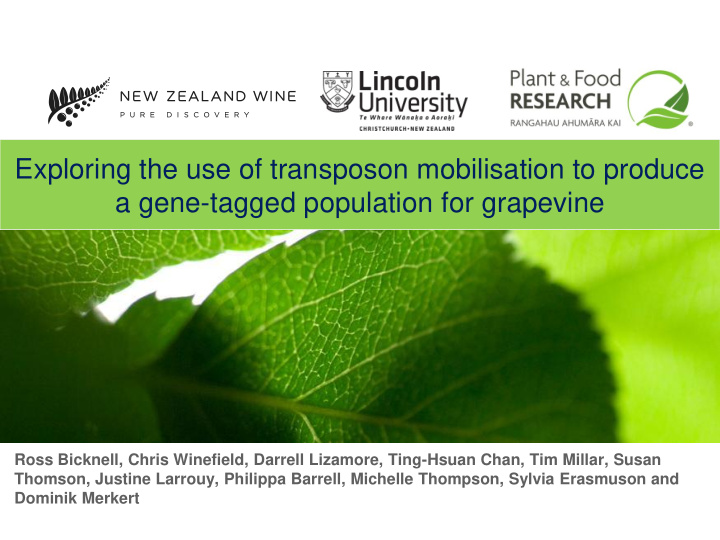



Exploring the use of transposon mobilisation to produce a gene-tagged population for grapevine Ross Bicknell, Chris Winefield, Darrell Lizamore, Ting-Hsuan Chan, Tim Millar, Susan Thomson, Justine Larrouy, Philippa Barrell, Michelle Thompson, Sylvia Erasmuson and Dominik Merkert
The Role of Transposons (TE’s) in Crop Improvement Maize ( Zea mays ): A Mite TE insertion near the tb1 gene was a key event in the domestication of maize (Studer et al. 2011) . Nectarines ( Prunus persica ) are hairless peaches. Vendramin et al. (2014) found that the fuzzy-less nectarine phenotype is caused by a TE in exon 3 of the PpeMYB25 gene. Cauliflower ( Brassica oleracea var botrytis): The purple mutant was found to be caused by a TE upregulating a DNA regulatory region controlling anthocyanin production (Chiu, Zhou et al. 2010). The orange coloured mutant accumulates high levels of b-carotene in the curd, was found to be caused by a TE insertion into the Or gene (Lu, Van Eck et al. 2006).
Transposon-induced Colour Change in Grape Lisch, D. (2013) Nature Reviews Genetics; 14 , 49 – 61.
The Reiterated Reproductive Meristem ‘RRM’ M utant The result of a transposed hAT element into the promoter of VvTFL1A , a meristem identity factor in the variety Carignan. Fernandez et al. (2010). Plant Journal 61 , 545-557.
Grape TE Programme Goals Determine the TE diversity in grape Establish reference genomes for our key varietals Establish tissue culture systems for TE mutagenesis Determine treatments that mobilise TE’s in grape Induction of transcription Achievement of integration Tools required to measure these events accurately Genotyping and Phenotyping Build a web-based browser for data visualisation Make the data available for forward and reverse genetic approaches
Transposable Elements in Grape TE’s make up 40 -50% of the grape genome, 32,500 different types identified, over 220,000 copies per cell
Transposon Movements are Cell-autonomous Events. They Result in Chimerism Periclinal chimeras Unpigmented Pigmented cells cells Anticlinal chimeras
Chimerism – Genetic Variation Within a Plant Pinot gris is a Periclinal Pinot meunier is a Periclinal chimera chimera Vezzulli et al. (2012) J Exp Bot. Boss and Thomas, M.R. (2002). 63:6359-6369 Nature 416, 847-850 An anticlinal chimera of To minimise chimeras we Sauvignon blanc use somatic embryogenesis
Optimising Somatic Embryogenesis in Grape Embryo formation and germination can both be stimulated by cold and GA3 treatment
Quantification of TE Mobilisation (‘TE Fingerprint’) Aim: To identify new insertions in each individual TE Fingerprint (Tim Millar and Susan Thomson) A computer programme written in Python Input data: Paired end sequence data (Illumina) Library of transposon sequences Grape genome sequence Output Identify paired reads at TE boundaries Map those and identify differences between individuals
hAT Element R elocation (using ‘TE Fingerprint’) Parent (leaf) Regenerant Regenerant Regenerant Regenerant Regenerant Regenerant
New Gypsy Insertion (using ‘TE Fingerprint’) Parent Regenerant Regenerant Regenerant Regenerant Regenerant Regenerant
Field Planting 1,300 somaclones planted to- date Another 1,200 ready to plant next season The first 100 fully genotyped The first fruit was seen in the 2017/18 season
Somaclonal Mutants One PN clone has altered dormancy. It breaks buds in mid winter and goes dormant in mid summer Three PN clones that are more susceptible to powdery mildew infection Two PN clones with a bushy habit (reduced apical dominance) Several plants with reduced vigour Fruit and bunch changes ? (too soon)
Thank You
Recommend
More recommend